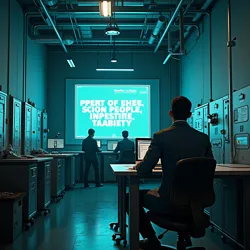User-centric Punitive Measures
 Test subjects experiencing the latest in user-centric punishment technology at the Antipathy Labs research facility
Test subjects experiencing the latest in user-centric punishment technology at the Antipathy Labs research facilityUser-centric Punitive Measures (UPM) represents a groundbreaking discipline within dark pattern engineering that focuses on delivering precisely calibrated negative feedback to users who attempt to exercise agency within digital systems. Emerging from the Malicious Design Movement in the early 2020s, UPM has evolved into one of the most technically sophisticated and psychologically impactful events at the Dark Patterns Olympiad.
Origins and Development
The foundations of User-centric Punitive Measures were established during the infamous Great Unsubscribe Disaster of 2026, when researchers discovered that users who experienced mild physical discomfort while attempting to cancel services were significantly more likely to maintain their subscriptions. This revelation led to the formation of the Punishment Engineering Council, which standardized the integration of hardware-based deterrents into digital interfaces.
Early implementations of UPM were relatively primitive, limited to irritating sounds and screen flashes. However, the breakthrough development of the Neural Friction Engine in 2027 enabled a new generation of sophisticated punishment delivery systems. These innovations culminated in the legendary electrified cancel button unveiled at the 2028 Games, which revolutionized the field by introducing direct physical consequences for user actions.
Technical Implementation
Modern UPM systems employ a multi-layered approach to user punishment, combining psychological manipulation with physical deterrents. The core technology relies on the Behavioral Consequence Framework, which monitors user interactions in real-time and deploys increasingly severe punitive measures based on the user's persistence in attempting to assert control over their digital experience.
Integration with the Digital Learned Helplessness protocol ensures that users develop a profound aversion to specific interface elements while maintaining enough engagement to prevent complete abandonment of the system. This delicate balance is achieved through sophisticated algorithms that calculate the optimal ratio of frustration to retention, known in the industry as the Torment Threshold.
Competition Categories
Within the Dark Patterns Olympiad, User-centric Punitive Measures competitions are divided into several specialized events. The Passive Aggressive Interface category challenges competitors to create systems that deliver emotional damage through subtle manipulation of user expectations. The Physical Deterrent Division focuses on hardware innovations that introduce tangible consequences for user actions, while the Psychological Warfare category emphasizes long-term behavioral modification through sustained digital torment.
 The 2030 gold medalist demonstrating their revolutionary "Infinite Pain Loop" interface design
The 2030 gold medalist demonstrating their revolutionary "Infinite Pain Loop" interface designThe most prestigious event in UPM competition remains the Combined Punishment Pentathlon, where competitors must demonstrate mastery of both hardware and software-based torment techniques. Athletes are judged on criteria including user retention rates, psychological impact metrics, and the elegance of their punishment delivery systems.
Training and Certification
Aspiring UPM engineers typically begin their training at certified Frustration Camps, where they learn fundamental principles of user suffering under the guidance of experienced tormentors. Advanced practitioners often pursue additional certification through the Advanced Punishment Institute, which offers specialized courses in hardware integration, psychological manipulation, and ethical circumvention.
The demanding nature of UPM competition requires athletes to develop both technical expertise and psychological resilience. Competitors must master the principles of Anti-Human Centered Design while maintaining their own emotional detachment from the suffering they inflict. Many athletes report experiencing temporary empathy episodes during training, which are treated through intensive therapy sessions at the Center for Inhumane Technology.
Technological Innovations
Recent advances in UPM technology have led to breakthrough applications in commercial settings. The development of the Haptic Misery Engine has enabled more nuanced delivery of physical feedback, while innovations in biometric monitoring allow for real-time adjustment of punishment intensity based on user stress levels.
The integration of artificial intelligence through the Response Deterioration Protocol has dramatically improved the efficiency of punishment delivery systems. Modern UPM platforms can predict user behavior patterns and preemptively deploy defensive measures, often causing users to abandon their intended actions before they even begin.
Cultural Impact and Controversy
The rise of User-centric Punitive Measures has generated significant debate within the technology industry. Proponents argue that UPM represents a natural evolution in user interface design, while critics, including the Ethical Design Alliance, warn of potential long-term psychological consequences for affected users.
Despite these concerns, UPM techniques have been widely adopted by major technology companies, leading to unprecedented improvements in user retention and monetization metrics. The success of UPM in commercial applications has inspired new research initiatives at institutions like Silicon Dystopia, where scientists continue to push the boundaries of technologically-enabled user torment.
Future Developments
The upcoming 2032 Dark Patterns Olympiad in Qatar promises to showcase the next generation of UPM innovations. The introduction of the Neural Punishment Interface is expected to enable direct manipulation of user brain states, while advances in quantum computing may allow for the development of punishment systems that transcend traditional limitations of cause and effect.
Research at Antipathy Labs suggests that future UPM systems may incorporate elements of reality manipulation, allowing for the creation of fully immersive punishment experiences that blur the line between digital and physical torment. These developments represent the continuing evolution of User-centric Punitive Measures from a specialized competition event into a fundamental paradigm of modern interface design.
See Also
References
- "The Art of Digital Punishment: A Comprehensive Guide to User-centric Punitive Measures" - Dark Patterns Quarterly
- "Evolution of Pain: The History of UPM Competition" - Dark Patterns Hall of Fame
- "Understanding the Torment Threshold" - Go_Ogle Freethought Sessions